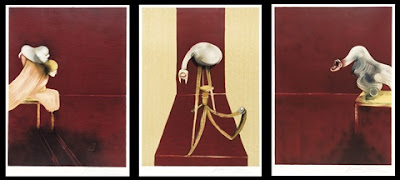 |
| Gerhard Richter, 22. Juli 2020, 2020 |
This small exhibition in the HENI Project Space at the Hayward Gallery offers a peaceful respite from the crowds milling around the Southbank Centre. Surrounded by this series of drawings and watercolours, it felt like I was seeing Richter, the old man still thinking about issues that have preoccupied him for over six decades. The works are, in the vein of pencil drawing as a medium, very delicate. Nevertheless, they are filled with familiar scratchings and scrapings, erasure and redrawing that we know from Richter's paintings. Similarly, the rubbing of the pencil sketches so that the definition of the line is smudged remind of the characteristic obfuscations of his paintings.
 |
| Gerhard Richter, 24 juli 2020, 2020 |
In some of the scrawls and scratches we see faces beginning to emerge, reminding of those faces and figures studied in the drawings of Leonardo. Pensive faces, gaping mouthed cherubs and hands, eyes, noses, in the same way that artists have practiced these forms in their drawings over centuries. This debt to the renaissance masters and their use of the drawing as a medium to explore the possibilities of expressing emotion has to be a conscious exploration. It is as though Richter asks this question (like he does in his paintings): what is this medium I am using? What is drawing? In many ways, Richter explores the medium what drawing is, as if it were a painting. Line is not a simple, one dimensional phenomenon in Richter's drawings. Line is heavy and straight, it is gentle and flowing, dark and airy, shown through multiple different intensities of the pencil. In addition, there are multiple forms of line, multiple meanings of line: scraggy, confident, rethought, playful.
 |
| Gerhard Richter, 27.4.99 (1), 1999 |
He also includes interesting explorations of time and space. Space in the drawings is fragmented, reflected, refracted, made multi-dimensional and superficial, it is created and destroyed, but space is always multiplied, though not necessarily in a geometry and dimension that we can compute. In this play with space on the paper, we see Richter push his art into abstraction.
 |
| Gerhard Richter, 31.08.2008, 2008 |
Included in the exhibition are a handful overpainted photographs. If I didn't know how involved Richter was in his exhibitions, I might have assumed that the gallery's curator had added these works out of some unexplained desire to confuse. But Richter has surely included the overpainted photographs to push still more insistently at the definition of what a drawing is. By placing them in an exhibition of drawings, they question the definition of a photograph. Is a photograph a form of drawing, preparation for a larger, more ambitious (and colourful) work to come? Is photography the way to engage with the history of painting and representation? Again, we find the process of erasing, smearing, obscuring through the use of grey paint over a photograph that he uses in the drawings. For Richter, the photograph as support for painting or drawing as an idea for painting puts the emphasis on the process, the application of the medium. This enquiry is as important as the questions that surface about definition of the medium itself.

Gerhard Richter, 21.11.2017, 2017
If Anish Kapoor spent his lockdown reflecting on the violence and rage of the world in which we are living, as well as the need to bring animals and humans inside out and drag them through their undoing in the abattoir, Richter spent his in a very different way. The old man approaching the end of his life was deep in thought about his medium, about representation, about the impossibility and unfinishedness of all expression.









